LED grow lights have been around for some time now. It’s a technology that seemed promising from the very off, yet cannabis industry seemed somewhat unconvinced on it for a number of years. Then, as the technology and its understanding have advanced, so has its acceptance built within the cannabis growing community. In this article, I hope to illuminate on the subject of LED grow lighting, without getting too technical, and answer the question: are LED grow lights the future of cannabis industry?
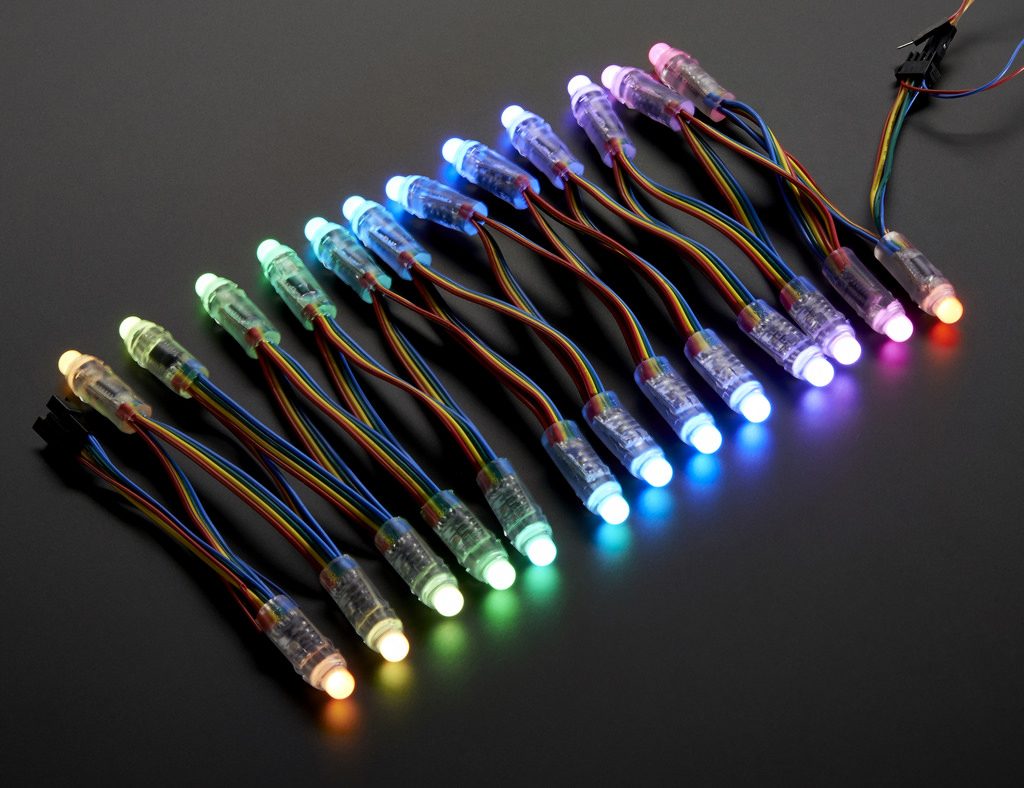
Pic of the old Dual In-line Package Diode (DIP)
In the beginning!
The LED grow light industry, from the very beginning, offered some enticing statements, such as, "the instant ability to save substantial amounts on your electricity usage", from both a drop at source (the lighting unit itself) or from the additional savings caused by such things as "not having to run air-con to keep heat levels under control". Now these are clear statements in reference against HPS growing and I simply bring this up as it's the main source of lighting that LED's are being constantly compared against. This brings us nicely to the safety aspect. LED lamps have always had the simple advantage of not operating at the extremely high running temperatures of HPS. This gives LED clear advantages from a fire safety standpoint and this, in itself, gave cause for many growers to quickly consider making the switch to LED. Now, in the very beginning, some of these claims seemed to get cancelled out, with many early LED grow lights receiving reports and reviews detailing a lack of light penetration or poor coverage. In some cases, even the promised heat reductions didn't come into realization, with only a minimal drop witnessed in environmental temperatures, if any at all. So frequently in the beginning, additional lighting units were needed to gain the same general results under LED, as may have been produced previously with an HPS setup. This combined with the often larger original outlay required for led grow lights, when compared against your average HPS setups cost, meant these claimed savings for your pocket, were not so easily obtained.
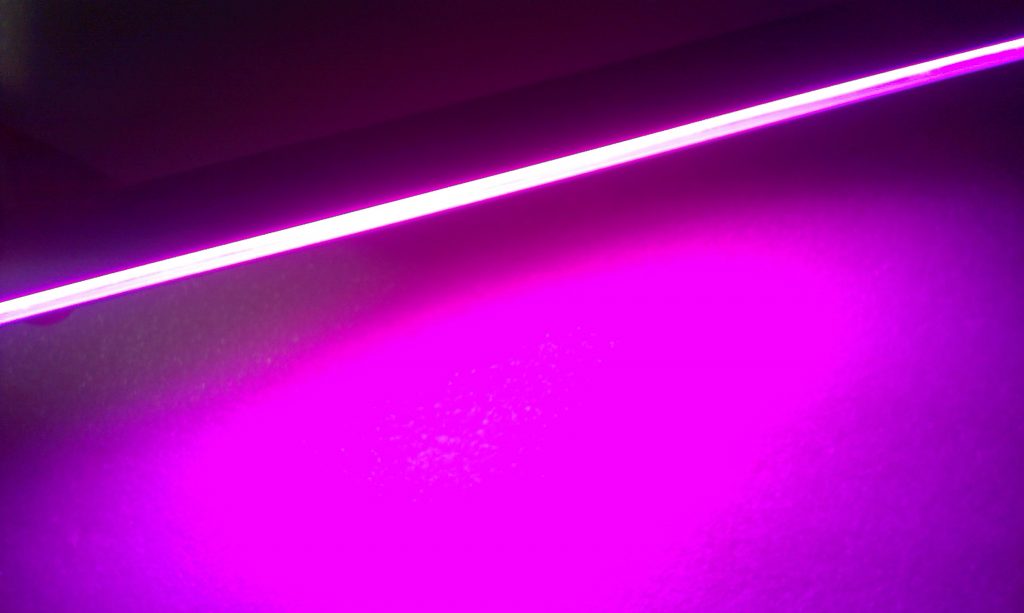
How have things changed?
Diode Manufacturers
The Industry has changed dramatically over the last couple of years, with some of the larger Diode manufacturers realizing this particular markets' potential. Leading to detailed research with regards to more targeted and reliable diodes suitable for horticultural usage. Quality levels in the production processes have also risen, leading to longer life-spanned diodes which have less drop-off; output wise, over the lamps' lifespan.
Lamp Manufacturers
LED grow lamp companies have now sprung up all over, all trying to cash in on this new and highly lucrative market. This has created a widespread and fairly diverse world of lighting options, certainly giving growers plenty to consider before making a lighting purchase. More options translates into competition between brands. This, in turn, has led to a number of noticeable trends over the last few years. One such trend has been the pulling away from low-end diodes with their unprecise colour spectrums. As in the beginning, you might have even found the same type of diode in your car break light as you found in your grow lamp! Also whereas in the beginning, a large portion of the markets' materials came from China, now many lamp manufacturers have looked to other more local sources for their required components. Whether that be, casings, drivers or the diodes themselves, as example; the American Cree diodes or even the German produced Osram diodes are now quite widely used.
General Agricultural use
LED has already started to be used on a widespread scale within certain parts of commercial agriculture. Namely markets such as floriculture/flower farming. This is set to continue onwards as farmers realize the potential savings in running costs once a LED setup has been installed and initialized.
Why is the very makeup of LED technology so promising?
LED (Light Emitting Diode) technology at in its very base form is an extremely versatile platform. Whether we're talking COB technology (Chip on board) or SMD (Surface mounted Device), they both share the same basic makeup of utilizing many smaller individual diodes to create a bank of light. This gives a level of versatility that is hard to match with other lighting technologies. Simply put, changing the percentage\ratio of any of the coloured diodes used would affect the spectrum of output/light tone, of the lamp. This, of course, means an LED lamps output can be targeted to a specific range, giving a far better light efficiency.
LED grow lights: different options
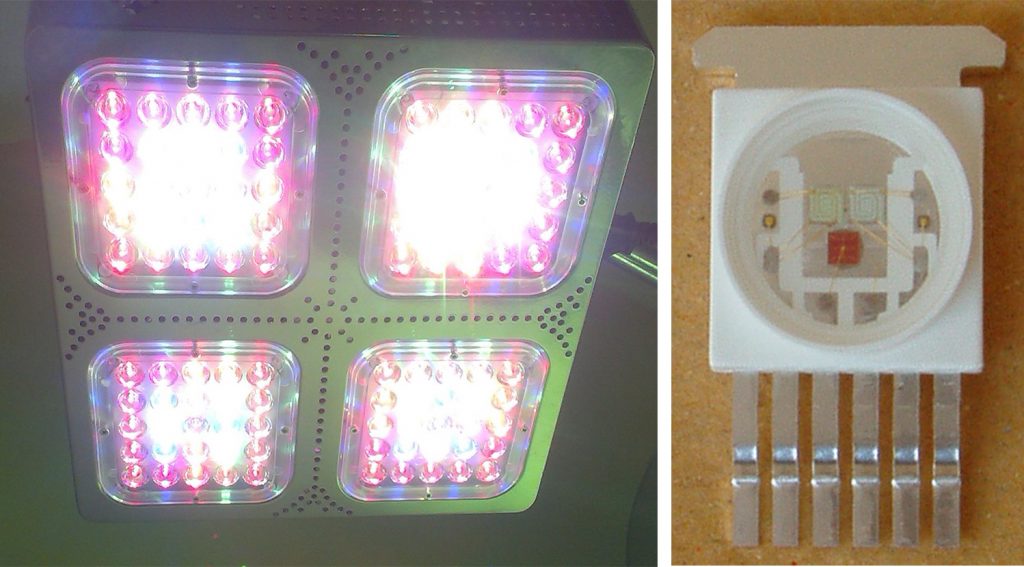
SMD (Surface mounted Device) Is a very versatile form of LED. These chips are far smaller than the previously mentioned DIP chips, yet can support multiple diodes per unit. This again gives the SMD chip the advantage through its ability to run multiple colours on the same unit. So, in theory, if an SMD chip were made up of a Blue, Green and Red diode, then any colour light tone is possible by simply adjusting the level of output through each diode on the individual chip. With this use of LED, each diode requires its own circuit. This, in turn, means each circuit requires its own pair of contacts. This can, therefore, complicate the design process of the lamp itself somewhat. So in the first picture above, you can clearly differentiate the individual coloured diodes. This means secondary lenses are frequently required to aid with the blending between the different coloured diodes present in its build makeup. This option often provides a more focused output of light and, therefore, tends to benefit in the form of strong light penetration through the canopy and foliage.
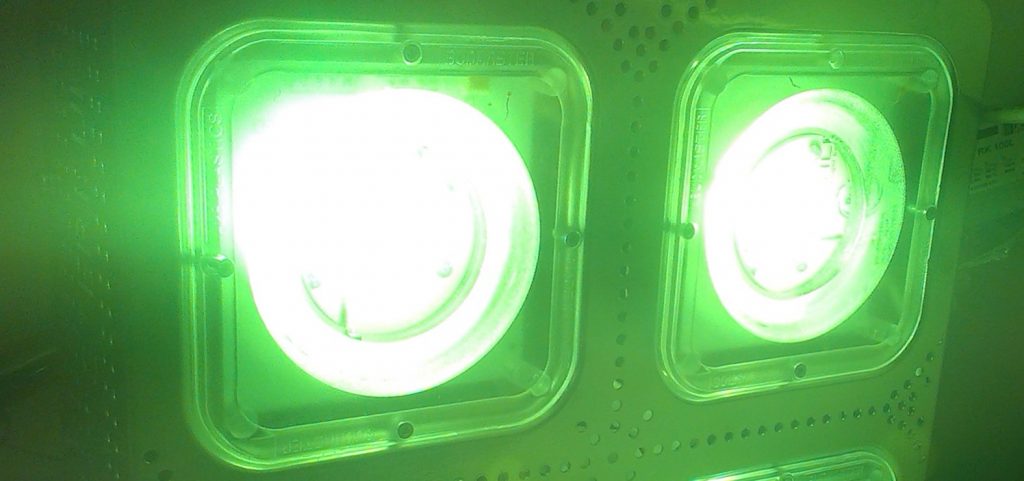
COB lighting (Chips on Board) is where you have multiple bare chips attached to one substrate, giving one circuit driving all chips. Once lit up, a cob looks like a single colour toned, small panel of light. In a single colour format, COB technology is extremely efficient, one of the reasons why recently a good number of full spectrum white cobs have hit the grow light market. Multiple colour cobs are, of course, already possible and promise to be something we see far more of as the technology evolves. Grow lights utilizing COB design, have the light blended at a source and, therefore, as a result, the required distance between your COB lamp and your plant canopy is often reduced in comparison to other forms of LED. This ability to run closer to the canopy has generally led COB lamps to be developed with reflectors or secondary lenses. This simply assists in the dispersal/spread of your lights output for greater area coverage. This, in turn, gives most COB grow lamps a less focused light output and therefore light penetration through foliage has been known to suffer.
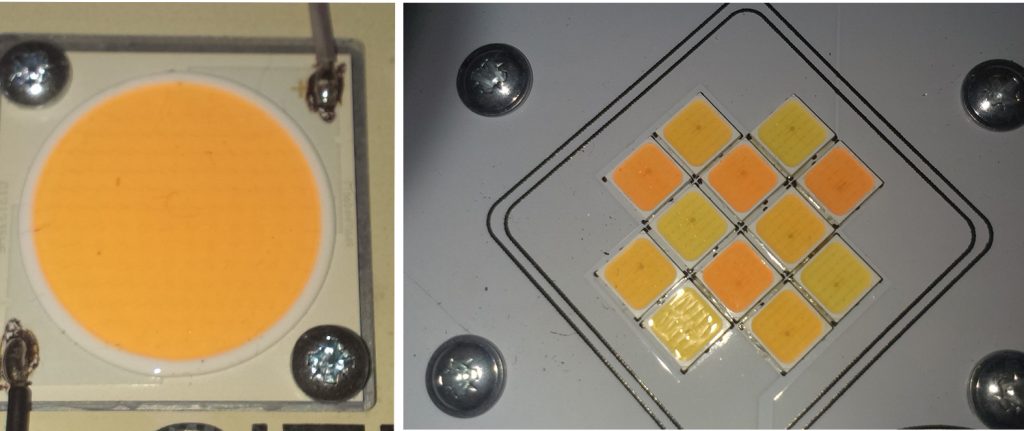
MCOB (Multiple Chip On Board) is an extension of normal COB tech and is basically a number of COB chips together in series. This technology has plenty of scope for development. So I'm sure we will see this used more and more as this market continues to develop.
Growing cannabis with LED
So growing under LED a few small adjustments need to be made to your growing regimen. The need to use additional Cal-Mag is widely known nowadays. Yet also, you need to think about temperatures, the drop in running temps may cause your watering/feeding requirements to slow down. This is just due to the transpiring of moisture from the pots slowing down, due to less wasted energy being generated by the LED's, wasted energy that normally translates into excess heat. This also stands for the plant itself, where not so obvious to the eye, plants also transpire and certain ranges temperature will also affect this process. Growth characteristics can also differ, the way a plant itself responds under LED can differ from what you've been used to previously, with many strains showing less distance between nodes, making for smaller bushier plants in the beginning of their lives. This may be attributed to the more precise light spectrums led lighting is putting out. Now one very common viewpoint for the last few years has been a consensus amongst LED growers, that the quality of the product produced under LED was of a higher standard than previously under other lighting sources (HPS). The apparent rise in quality, seemed based on simple observations of flower grown under LED having more terps, higher oil content/noticeable rise in trichome production. At the very same time, though, these same people were often commenting that yields may have dropped off slightly. This simple observation is one that aided in LED becoming more widespread amongst your small home growers, where quality was perhaps more important than quantity. Commercial growers, though, seemed very hesitant at first to make the switch, maybe due to the influence on immediate cash returns.
Where lies the future?
With LED technology and its inherent adaptability, the future seems one with many possibilities. Whether through advancements in LED technology itself or through developments in linked technology, such as heatsinks, substrates and general mounting processes used, with so many variables to play with there is a near infinite pool of options ahead of us. Increases in output; Recently there's indeed been a noticeable movement to more high-powered diodes. With a percentage of companies turning towards 5 watt diodes or higher. Increases in light spectrum efficiency; Companies are all striving to find the best fit for cannabis cultivation, experimenting with things such as UV (Ultra Violet) or IR (Infrared) to promote better oil production from our plants! Finding that sweet spot, between power and the spectrum output, seems to be the key at present in producing the best LED grow lights tailored for Cannabis cultivation!
Advancements in technology
One that's recently emerged is the QD (Quantum Dot). This a technology that should excite us all. Quantum Dots are literally grown in a laboratory. They're tiny crystals that can be produced to an extreme level of precision. Each QD crystal may be only 10-100 Atoms across! The number of atoms in each QD correlates directly to the specific output of said QD crystal once its agitated by another light source. So with this ability to tailor light to such precise wavelengths, comes the possibility to target LED light to correspond with the precise needs of a plant when it comes to photosynthesis. This again is a step forward on the accuracy of existing LED lighting, driving it even further beyond the level of efficiency available with other lighting sources at present!
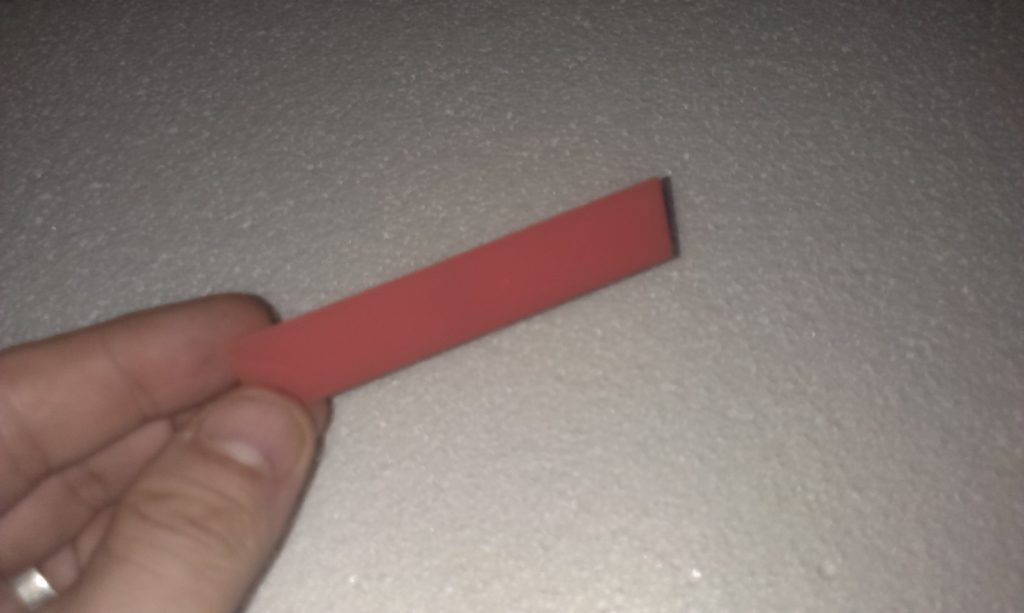
Quantum Dot Film
Summary
Take the extreme versatility of LED, then combine it with an industry that's growing at a phenomenal rate and generates massive cash flows worldwide and add to the mix each brand/manufacturer, striving to stand apart from the rest, and, within this, lies the future of LED in agricultural markets and of course cannabis cultivation. This is a time where I truly believe LED grow lights will start to eclipse our old friend HPS in its common usage. Researched and written by Light Addict.





Hi, Thank you for your nice information. You doing a great job. If you are looking for the best LED grow light for your setup, you can look for Nova N300s Dual Spectrum 300W. https://www.hifigadget.com/best-led-grow-light-nova-n300s-review/
Great article. Made me feel much better about the lights in just bought. T eye ingredients a few of your seeds soon. Can't wait! Thanks!